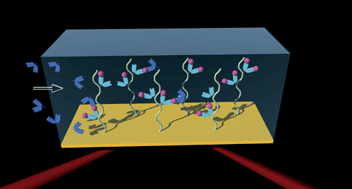Detection of picomolar levels of interleukin-8 in human saliva by SPR
Abstract
Researchers at UCLA have discovered that the levels of interleukin-8 (IL-8)

Maintenance work is planned from 09:00 BST to 12:00 BST on Saturday 28th September 2024.
During this time the performance of our website may be affected - searches may run slowly, some pages may be temporarily unavailable, and you may be unable to access content. If this happens, please try refreshing your web browser or try waiting two to three minutes before trying again.
We apologise for any inconvenience this might cause and thank you for your patience.
* Corresponding authors
a
UCLA's Department of Bioengineering, 7523 Boelter Hall, 420 Westwood Plaza, Los Angeles, CA, USA
E-mail:
cdm@seas.ucla.edu
Fax: +1 310-794-5956
Tel: +1 310-794-7270
b UCLA's Dental Research Institute, 73-017 CHS, 10833 Le Conte Ave, Los Angeles, CA, USA
c UCLA's Mechanical and Aerospace Engineering Department, School of Engineering and Applied Science, Engineering IV, Room 38-137J, 420 Westwood Plaza, Los Angeles, CA, USA
d UCLA's Division of Head and Neck Surgery, 200 Medical Plaza, Suite 550, Los Angeles, CA, USA
e UCLA's Jonsson Comprehensive Cancer Center, 8-684 Factor Building, Box 951781, Los Angeles, CA, USA
f UCLA's Molecular Biology Institute, Boyer Hall, Box 951570, Los Angeles, CA, USA
Researchers at UCLA have discovered that the levels of interleukin-8 (IL-8)

 Please wait while we load your content...
Something went wrong. Try again?
Please wait while we load your content...
Something went wrong. Try again?
C. Yang, E. Brooks, Y. Li, P. Denny, C. Ho, F. Qi, W. Shi, L. Wolinsky, B. Wu, D. T. W. Wong and C. D. Montemagno, Lab Chip, 2005, 5, 1017 DOI: 10.1039/B504737D
To request permission to reproduce material from this article, please go to the Copyright Clearance Center request page.
If you are an author contributing to an RSC publication, you do not need to request permission provided correct acknowledgement is given.
If you are the author of this article, you do not need to request permission to reproduce figures and diagrams provided correct acknowledgement is given. If you want to reproduce the whole article in a third-party publication (excluding your thesis/dissertation for which permission is not required) please go to the Copyright Clearance Center request page.
Read more about how to correctly acknowledge RSC content.
 Fetching data from CrossRef.
Fetching data from CrossRef.
This may take some time to load.
Loading related content
